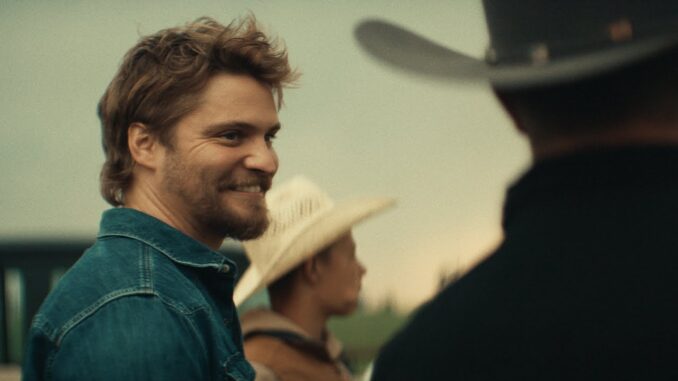
As the anticipation builds for the return of Yellowstone this November, fans are buzzing about the show’s new direction. Kevin Costner’s departure has left a big gap, but fear not! The rest of the beloved cast, including Cole Hauser, Kelly Reilly, and Wes Bentley, is back to keep the Dutton drama alive. But while we wait for the next chapter in the Yellowstone saga, Luke Grimes—who plays the rugged Kayce Dutton—has taken a moment to spotlight the real-life essence of Montana through a new short film, Made in Montana.
What Is Made in Montana All About?
In the seven-minute mini-documentary, Grimes delves into the daily lives of the hardworking farmers and ranchers in Bitterroot Valley, showcasing the grit and dedication that keep this stunning landscape thriving. As he narrates, you can feel his passion for the land and the people who work it. Grimes emphasizes how easy it is to forget the effort that goes into putting food on our plates when you live in a place like Montana.
“Without those people and their hard work, the rest of us wouldn’t be able to eat,” Grimes shares, reminding us of the unsung heroes of the agricultural community.
The film, made in collaboration with Carhartt, celebrates these everyday warriors by capturing their stories and highlighting their contributions to the state’s rich culture. Carhartt has a longstanding commitment to the hardworking men and women of America, and this initiative is a testament to that legacy.
The Heart and Soul of Montana
Celebrating the Backbone of America
Montana is more than just a picturesque backdrop for a hit TV series; it’s home to generations of families who have nurtured the land for decades. Made in Montana highlights how local communities are facing challenges, especially with outside interests, including billionaires buying up vast tracts of land for recreational use. Grimes aims to shed light on the importance of preserving the agricultural lifestyle that has defined this region for so long.
The short film showcases not only the beauty of the Bitterroot Valley but also the struggles of its residents. It focuses on the value of skilled trades and how these traditions are passed down through generations. Grimes himself was drawn to this lifestyle, having settled in Montana, where he finds inspiration both as an actor and a musician.
Community and Conservation Efforts
The film also discusses the role of local nonprofits like the Bitter Root Land Trust (BRLT), which works with landowners to protect their properties through conservation easements. This partnership is crucial for maintaining the balance between development and conservation, ensuring that Montana’s natural resources and heritage are preserved for future generations.
Through these conservation efforts, the BRLT helps safeguard working farms and ranches, wildlife habitats, and essential water resources. This grassroots movement emphasizes the significance of community-driven solutions in tackling environmental challenges.
Carhartt’s Commitment to Montana
Support for the Agriculture Community
In addition to raising awareness through Made in Montana, Carhartt is contributing a substantial $350,000 to The Nature Conservancy (TNC). This funding will bolster land preservation efforts across the state, ensuring that Montana’s farming and ranching heritage remains intact.
The partnership between Carhartt and TNC focuses on innovative community programs, such as grass-banking, which allows ranchers to graze their cattle on conserved lands. This mutually beneficial relationship supports both the agricultural community and the environment, creating a sustainable model for future generations.
New Gear Inspired by Hard Work
Alongside the short film, Carhartt has launched a Montana series, featuring workwear that embodies the rugged spirit of the American West. This line includes jackets, outerwear, and other essential gear designed for durability and functionality—perfect for those who work the land day in and day out.
Susan Hennike, Carhartt’s chief brand officer, emphasizes the brand’s commitment:
“Their locally implemented preservation solutions will only strengthen the legacies of the hardworking generational farmers and ranchers who live and rely upon the land.”
The Impact of Made in Montana
Raising Awareness and Celebrating Legacy
Made in Montana is more than just a film; it’s a call to action. By sharing the stories of local farmers and ranchers, Grimes and Carhartt are inspiring viewers to appreciate the labor that goes into sustaining the land. This short documentary encourages people to think critically about the food they consume and the people who grow it.
As Grimes passionately narrates, we’re reminded of the importance of valuing our agricultural communities and supporting efforts to preserve their way of life. In a world where urbanization is increasingly encroaching on rural spaces, it’s vital to honor the legacies of those who have worked the land for generations.
Emphasizing the Importance of Hard Work
This initiative highlights not just the struggles but also the triumphs of Montana’s farmers and ranchers. It serves as a reminder that behind every meal is a story of hard work, dedication, and a deep-rooted connection to the land. Grimes eloquently puts it:
“Farmers and ranchers have always been the backbone of America, providing the nation with essential food and natural resources.”
Conclusion: A Heartfelt Tribute to Montana
As Yellowstone gears up for its return, Luke Grimes’ Made in Montana serves as a beautiful tribute to the state he calls home. It captures the essence of the hardworking people who embody the spirit of the American West, reminding us all to appreciate the effort that goes into sustaining our food systems. This mini-documentary not only honors the agricultural community but also shines a spotlight on the importance of conservation and local efforts to preserve Montana’s landscape for generations to come.
FAQ: What Can I Do to Support Local Farmers and Conservation Efforts?
You can support local farmers and conservation efforts by buying locally sourced products, participating in community-supported agriculture (CSA) programs, or volunteering with local nonprofits focused on land preservation. Every little bit helps keep the agricultural heritage alive and thriving!
